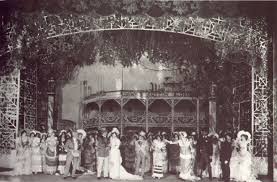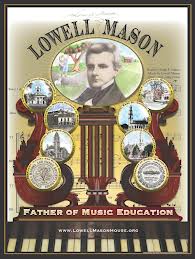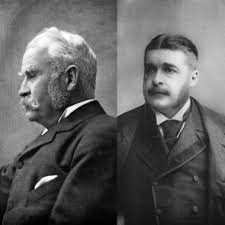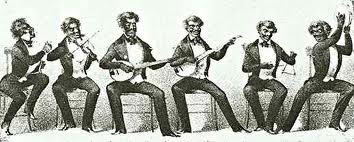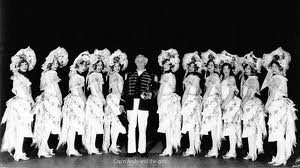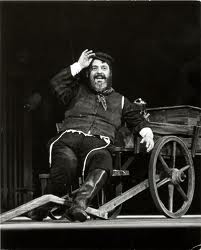There are numerous factors that led to the development of the book musical in America. If we can say that in 1927 Kern and Hammerstein created the first successful American book musical with the premiere of Show Boat, we can look back to some specific circumstances and instances that led and pushed the musical to that point. Here are five factors that set the stage for the birth of the book musical.
Musical Traditions
In its earliest days, the U.S. had a strong musical tradition that was tied to Europe. One man, Lowell Mason, helped to formally establish vocal music as part of the public school curriculum. Mason, who wrote the Christmas tune Joy to the World, created popular songbooks that were filled with tunes and words that in no way would offend. These became a part of the parlor of every middle class home in America and sat on pianos that would be played during family sing-alongs and when friends gathered.
In 1833, Mason and two music associates established the Boston Academy of Music. The institution was created to popularize the art of singing, set high standards for church music, and to help introduce music education in the public schools. Within a year, the school had 3,000 students and within the next five years Mason would see music become a formal part of the Boston public school’s curriculum. The vocal music movement spread across the state and eventually music became a part of all U.S. public schools.
Lowell Mason helped establish a tradition for vocal singing in the U.S. by getting it introduced into the public schools and by creating popular song books that sold over 50,000 copies. For him vocal singing was very democratic- it was not for the few to engage in, it was for everyone. He helped to get everyone singing and created an atmosphere that was welcoming to and accepting of vocal music.
American Operetta
In 1878-79, America saw a revolution on the musical stage. It was actually an invasion of sorts, as Gilbert and Sullivan’s H.M.S. Pinafore crossed the Atlantic from England and became an instant success. There were over 150 professional productions of the operetta in one year. Americans loved Gilbert and Sullivan and suddenly English operetta was the rage. The popularity of the form led to the creation of operettas by U.S. composers including Reginald DeKoven, Victor Herbert and John Phillip Sousa. American composers were firmly tied to European music traditions and forms but the indigenous creation of operetta, which included a story and characters, was an important development in U.S. musical theatre.
The Minstrel Show
The minstrel show was another very popular type of entertainment in the U.S. Its racists elements are well documented, as are those of all aspects of U.S. theatre from its earliest years up to the 1960s, but the minstrel show was extremely important when it came to the creation of American musical theatre. The minstrel show utilized music that was connected to American folk idioms. It had a homey feel that reflected American sentiment and emotion. American composers like Stephen Foster were creating songs that were truly American musically, lyrically and experientially.
George M. Cohan
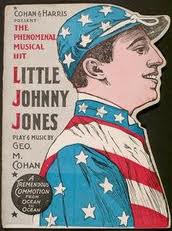
The musical Little Johnny Jones helped make Cohan famous. It was a big step towards the book musical.
If history is made by individuals, then George M. Cohan is one such individual, as he is credited by many as singlehandedly creating the Broadway stage of today. Cohan was a song and dance man who came from a song and dance family. But he had big aspirations and a big ego. Cohan created musicals for the stage, writing the music, lyrics and book, and also produced, directed and starred in them.
His musicals, which included Little Johnny Jones and Forty-five Minutes from Broadway, and plays and revues number over 50. From 1904 to 1920, he wrote and published over 300 songs, including Over There, Yankee Doodle Dandy, Give My Regards to Broadway and You’re a Grand Old Flag.
Cohan was important for a few reasons. Although his musicals can’t quite be called book musicals, they helped span the gap between operetta, which was mostly sung, and the American book musical, which relies so heavily on character and dialogue. Also, Cohan’s songs capture the energy of America and are a far cry from the formal music connected with European and English operetta. They have rhythms, tempos and phrases that connect with the dancer in Cohan and with tap and jazz. Finally, Cohan’s themes were uncompromisingly American and when combined with his stage art and written works he epitomized the true potential of the American musical composer, lyricist and book writer for greatness.
Visionary Creators and Producers
The birth of the American book musical came down to three men—Oscar Hammerstein II, Jerome Kern and Florenz Ziegfeld. When Hammerstein and Kern joined forces to create Show Boat both were dedicated to doing something unique. That “something different” was transforming the genre of musical comedy, which was mainly songs strung together by a thin plot, filled out with old and new jokes and energized by dances and effects, into an artistic entity in which music, lyrics and book were totally integrated.
Ziegfeld is important because he backed the production of Show Boat. This was surprising because Ziegfeld was known for producing the follies show that was branded with his name. It’s fairly certain that the big name producer did not quite know what he was going to get with Show Boat. He did not think he was backing a serious show but rather more of a musical comedy. He was extremely nervous about the show’s premiere once he realized what it had become, but yet he had faith in Kern and Hammerstein.
The Greatest Book Musicals
Show Boat is considered to be the first great book musical. Many more would follow, including Oklahoma!, West Side Story, My Fair Lady, and Fiddler on the Roof. We’ll be looking at some of the great book musicals in this ongoing series

